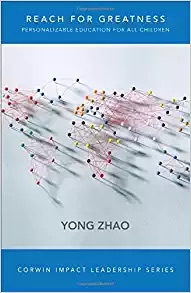
Reach for Greatness: Personalizable Education for All Children by Yong Zhao argues for a transformation of our schools from a focus on deficits and remediation to a focus on strengths and making every student great in their own way. It makes a short and compelling case for giving students more control and more responsibility for their learning and their futures. Please grab a copy and send one to any policymaker you know.
Introduction
- Yong uses his own story about how he wasn’t good at farming chores and that his father had the good sense to send him to school. At the time he was also able to avoid subjects he wasn’t good at or not interested in. This allowed him to leave China for the US and to become a college teacher. He compares this to our system that rather than focusing on student strengths focuses on their deficiencies. The system assumes that every student should learn the same knowledge and skills (standards) and that they should all demonstrate the same level of proficiency.
- While federal mandates have changed a bit, there is still an unreasonable focus on closing achievement gaps. He maintains that achievement gap mania has changed America for the worse. Changes in society continue to redefine the knowledge and skills that will be useful as some skills become obsolete. Humans are differently talented so we need to stop preparing students to become a homogeneous group of average individuals who are mediocre at everything but great at nothing. We need to begin helping everyone become great.
1. The Ambitious Pursuit of Mediocrity: How Education Curtails Children’s Potential for Greatness
- Our education system is a meritocracy that rewards students who do the best on the tests they take in a limited number of subjects. If you can jump through the required hoops on schedule, you will do fine. If your interests and talents don’t fit the curriculum, it will damage your confidence and self-esteem, and your talents are likely to be wasted. Ironically, meritocracy leads to mediocrity.
- The tests are norm-referenced so if one student goes up another goes down. (Doug: This is known as a zero-sum game. If you see percentiles, that is what is happening.) The tests only assess the ability to take the tests. As a result, Einstein and your top physics student both get the same grades. (Doug: There is no way to spot outliers.) Merit is defined a one’s ability and interest in performing well on tests in a few subjects. Thankfully, a growing number of schools have begun to implement programs such as genius hours and maker spaces, but they are still limited in scale and reach.
2. All Children Are Above the Average: The Potential for Greatness
- While all children cannot be above average on any single scale, there are so many ways to be above average on something that Yong believes that all children can be above average at one or more things. It is up to the adults in their lives to help children find out just what their individual strengths and weaknesses are. Since everyone is unique, there really isn’t any such thing as an average person.
- Yong mentions a number of ways to judge ability. There is Howard Gardner’s multiple intelligence theory, Dan Pink’s left and right brain directed thinking, Goldberg’s personality traits, and Reiss’ passion and intrinsic drives desires. Talent, personality, and passion are foundational sources of strengths and weaknesses and they are enhanced or suppressed by experiences. As you look for potential for greatness, avoid applying a predetermined set of criteria to all students. This includes curriculum standards as a student’s strength may lie outside their narrow definition.
- All human beings possess creativity. This is the ability to come up with new ideas, methods, theories, concepts, and products. Every student has a combination of innate qualities and environmental experiences that helps turn her or him into a unique individual. When you look hard without preconceived views, you will find them in all children.
DrDougGreen.com If you like the summary, buy the book
Pages: 1 2





